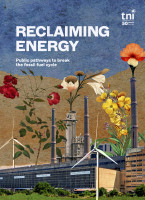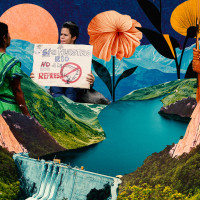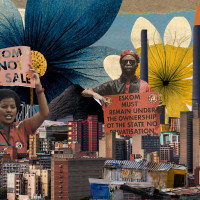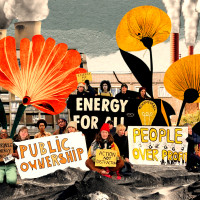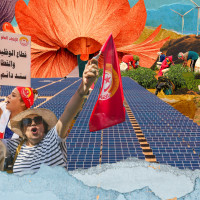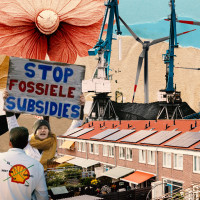Defending popular sovereignty and Indigenous peoples’ rights in Mexico Energy transition country struggle
Regions
After three decades of neoliberal reforms, Mexico’s energy sector is now plagued by privatisation, fossil fuel dependency and exploitative ‘green’ energy projects. Public opinion and media portrayals are highly polarised. While many media sources paint a picture of privatisation as a modern solution to Mexico’s problems, trade unions, Indigenous leaders and activists point to escalating crises rooted in the for-profit energy system.
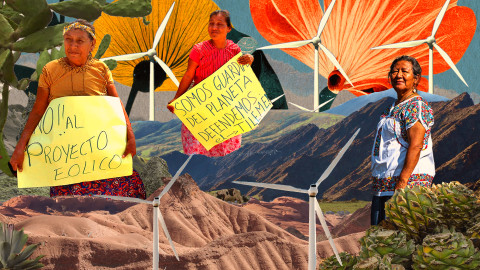
Illustration by Fourate Chahal El Rekaby
Privatisation and its aftermath
Over the past 90 years, Mexico’s energy sector has experienced substantial transformation. After the Mexican Revolution, the new Mexican Constitution (1917) stipulated that ownership of natural resources such as land and water would be granted to the Mexican state, making way for comprehensive nationalisations throughout the 1930s.3 Under the leadership of the social democratic PRI (Partido Revolucionario Institucional), the energy sector was first reorganised in the 1930s. In 1937, the federal electricity commission (CFE), a state-owned and state-financed enterprise, was created. CFE’s main tasks were the generation and distribution of electricity to Mexican households.
In 1960, the electricity industry was nationalised, giving the government exclusive responsibility for electricity generation, transmission and distribution. The nationalisation effectively created a monopoly on electricity for CFE and ended a decade-long dispute over foreign-owned electric power firms that controlled nearly 70 per cent of the market.4 By 1992, CFE achieved an electrification rate of over 93 per cent.5 As of 2020, according to official documents, access to electricity in Mexico was as high as 99 per cent – although this figure is challenged by civil society organisations.6
With the growing rise of neoliberalism and large-scale privatisations in many countries, and under pressure from the United States, Mexican politicians began to adopt a similar mentality in the 1990s. Between 1990 and 1992, essential sectors were privatised, such as the telecommunications sector, with the sale of Telmex for $6 billion in 1990.7 In 1992, a law was passed allowing the participation of private corporations in energy generation. The law remained heavily debated for a decade and, in 2002, the Mexican Supreme Court eventually ruled that it may have been unconstitutional, though no clear-cut ruling was presented. Further attempts at unbundling the energy sector were made in the late 1990s and early 2000s, with the goal of rebranding energy as a commercial rather than a public service and allowing independent power producers to sell directly to industrial customers and CFE under long-term contracts. However, both attempts failed and, as required by the constitution, the electricity sector remained federally owned, with CFE in control.
In 2013, President Peña Nieto made another attempt at privatisation, this time amending the constitution to promote private sector participation in the energy market. Between 2013 and 2014, Peña Nieto’s administration made 20 legislative changes and three constitutional amendments that opened the Mexican energy market to private companies, both national and foreign.8 In effect, this pushed Mexican energy policies back to pre-nationalisation days, making it possible for private companies to extract and handle resources on behalf of the State, to generate energy and sell this on to CFE, and to own and invest in renewable energy projects.
Since then, CFE has been hollowed out, its functions reduced to that of an administrative entity, with private corporations now owning and controlling energy generation.9 An independent operator, the National Center for Energy Control (CENACE), was introduced to coordinate a marketised energy sector, where private companies and CFE compete to generate and sell power.10 As a consequence of the reforms, electricity prices increased by 35 per cent between 2015 and 2017.11 Meanwhile, CFE and PEMEX (the Mexican state-owned petroleum company founded in 1938), which were considered strategic entities with a social orientation prior to the liberalisation of the energy sector, have been turned into for-profit state-owned entities.
Reclaiming public control
Elected in 2018 on the promise of reducing Mexico’s dependence on foreign imports and improving social and economic well-being, President Andrés Manuel López Obrador (known by his initials AMLO) of left-wing party Morena took on the task of reversing the country’s energy privatisation. In September 2021, AMLO introduced a plan to annul the 2013 energy reforms, undoing energy liberalisation and increasing energy sovereignty. 12 Proposed reforms included the cancellation of contracts with private energy generators and increasing the share of energy generation contracts reserved for CFE from 38 per cent to 54 per cent. However, in April 2022, he could not win the two-thirds congressional majority required to approve the reforms, as private interest groups lobbied against the plan. Of the 334 votes necessary to amend the constitution, only 275 were obtained.
Just days after this vote, President AMLO secured a partial win in nationalising the country’s lithium industry, one part of the reform package. The amendment to the National Mining Law was given fast-track treatment and approved by both chambers of the Mexican Congress in late April 2022. The reform of the Mining Law declares lithium resources a public utility, limiting exploration and exploitation rights to the Mexican state. A new decentralised public body, a state-owned company called LitioMx (Litio para Mexico), was created in August 2022 to oversee this.13 However, public ownership of lithium resources will only benefit Mexico’s people if the government uses its power to resist excessive export-oriented extraction and to promote a just transition led by and for the Indigenous and Mexican populations.
AMLO’s proposed energy reform has received harsh criticism from governments across the global North, in particular the US, who claim that preferential treatment for state-owned enterprises would violate Mexico’s free trade agreements.14 Additionally, energy multinationals claim that the nationalisation of energy will raise energy costs. Strong criticism also comes from environmental groups, who assert that the AMLO government is favouring fossil-fuel-based electricity and aims to shut down privately developed renewable energy projects, such as solar farms and wind parks. This is a vast simplification of reality.15
In January 2022, 76.4 per cent of electricity generation was based on fossil fuels, causing Mexico to import large quantities of oil and gas.16 While the country exports crude oil, domestic production and refining are limited, so Mexico is a net importer of refined petroleum products. Given that the current structure of the energy sector ultimately depends on fossil fuels, reducing domestic production and refining further would require increased imports to meet energy demand. Alternatively, the country can produce and refine more oil domestically, decreasing international dependencies. By renationalising the energy sector, these processes can take place under public control rather than for a profit motive. This gives the state the capacity to move forward with an economy-wide electrification of transport, heating and cooling systems – a decades-long process that is necessary to transition to renewable energies and leave fossil fuels behind.17 In this light, in April 2023, AMLO announced the $6 billion purchase of the bulk of Spanish private firm Iberdrola’s Mexican generating assets, including 12 combined cycle generation gas-fired power plants and one wind farm. AMLO described this move as a ‘new nationalisation’, which will increase CFE’s market share from 40 per cent to 55.5 per cent.18
AMLO’s proposal is better understood as an urgent tool for a pro-public energy transition, rather than an attack on renewable energy. Indeed, Mexico’s privately owned renewables sector has produced much more electricity than there was demand for. As a result of the privatisation policies of the previous president, Peña Nieto, the Mexican Regulatory Commission (CRE), a new body created in the early nineties for the benefit of independent power producers, has granted private energy generators permits to increase energy supply to 84 GWh.19 However, the holding capacity of the transmission grid lies at 47 GWh, and national demand for energy has never exceeded that volume, giving no reason to almost double energy supply. Although electrification will require the grid to be expanded, for the moment, these additional renewables are simply going to waste while lining the pockets of private investors. If electricity generation and transmission were both in public hands and integrated, an increase in renewable production could be planned in conjunction with expanding the grid and reducing fossil fuel power.
In this context, in early 2024, AMLO introduced a reform bill to dissolve CRE. When passed, CFE, the federal electricity commission, will have more policy room to prevent these for-profit producers from entering Mexico’s power sector and to manage the nation’s grid with the aim of energy sufficiency and sustainability.20
Mobilising against privatisation
For decades, Indigenous groups have highlighted the problems of private renewable energy projects in Mexico. Among the most well-known and contested projects are the wind farms in the Isthmus of Tehuantepec, a natural wind corridor between the Gulf of Mexico and the Pacific Ocean. 28 wind farms have been set up on the isthmus, which together generate 62 per cent of Mexico’s wind energy.21 The largest, the Oaxaca wind farm, opened in May 2019, with 132 new turbines. This added renewable energy capacity comes at a cost, threatening the livelihoods of several Indigenous groups who live in the area.22 As established in international law, Indigenous peoples have a right to consultation prior to the establishment of projects on their land. However, Indigenous communities affected by the Oaxaca project report that they were not consulted and were not given the chance to voice their concerns before construction began. With the wind farm now up and running, land used for traditional agricultural practices is being polluted, and wildlife driven away.
Indigenous populations have organised themselves to stop the construction of these exploitative wind projects, for example by blocking access to the area or taking matters to the Supreme Court. When the Zapotec community sued private energy multinational Energía Eólica del Sur due to the lack of prior consultation, the Supreme Court initially ruled in favour of the Indigenous group but ended up reversing a temporary suspension of the project.23 Indigenous peoples standing up to private investors have repeatedly reported harassment, threats of violence, and persecution by private corporations and local police.
In an attempt to provide an alternative to privately-owned wind parks, the Ixtepec community of Oaxaca developed its own community-owned wind farm.24 In collaboration with Yansa Group, an overseas foundation, the community designed the project through a participatory and democratic process, involving several community meetings and inclusive decision-making. However, the previous government refused to grant permission for the project, stating that government requirements were not fully met. Instead, private company Enel Green Power was granted permission for the construction of a wind farm. The unwillingness of the previous AMLO government to support Indigenous communities’ renewable energy projects undermined the democratic legitimacy of the Mexican State.
Towards a just transition?
A democratically organised and publicly owned energy sector, alongside popular sovereignty over lithium and other transition-related resources, is crucial to enable Mexico to move towards renewable energies. However, reclaiming public control must go hand in hand with a clear commitment to a timely and just energy transition. As of today, transparent action is still lacking from the Morena government. While the AMLO administration repeatedly assures the public that a return to state ownership will offer social and environmental benefits and enable the government to reach its climate targets, the population is still waiting for these promises to be fulfilled. At the same time, despite severe opposition, AMLO has been taking steps towards producing public renewable energy.
At the state level, Mexico’s first large-scale public renewable energy projects were initiated in recent years, most notably the $1.68 billion solar plant in Puerto Peñasco, which stretches over 2,000 hectares.25 The solar plant, set to be the biggest in Latin America, symbolises an important step towards publicly owned renewable energy generation. Additionally, it sets a precedent for large-scale public–public partnerships as a partnership between CFE and the Sonora state government underpins the project. The project was authorised in July 2021 and construction is expected to be finalised by 2027. The joint venture will be co-owned by CFE (54 per cent) and the Sonora state government (46 per cent) and will be financed entirely through debt.26 The debt financing will be initiated through export credit agencies, most of which will be issued in the form of a 14-year, below-market-interest-rate loan from Sweden’s export credit agency, EKN. The plant will have a generation capacity of 420 megawatts, sufficient to meet the energy needs of northwestern Mexico, and will be essential to avoid energy rationing, according to CFE. However, to promote rather than undermine the interests of Indigenous and other frontline communities, the public venture must go beyond mere community consultation. It must radically apply human rights mechanisms such as Free, Prior and Informed Consent and the Declaration on the Rights of Peasants and Other People Working in Rural Areas in ways that ensure affected populations can really co-design the entire process.27
To transcend a centralised model of public ownership and further embrace the democratisation of the energy sector throughout the country, trade unions and some environmental activists point to the need for more comprehensive constitutional reforms.28 Reforms pertaining to the rights of Indigenous Peoples and Afro-Mexicans are necessary to recognise these communities as ‘sujetos de derecho público’ (bearers of public rights). This, in turn, would constitutionalise autonomous forms of government, communal landholding and the right of Indigenous peoples to co-govern the natural resources and mineral wealth of their lands. The recognition of these diverse forms of governance are necessary to move beyond the neoliberal and exploitative structure of Mexico’s energy market and achieve a just energy transition for all its inhabitants.
In June 2024, Claudia Sheinbaum was elected as the new president of Mexico with a sweeping majority. She is a climate scientist with a PhD in energy engineering, giving hope to trade unions and movements alike that she will accelerate a just energy transition. Her campaign commitments included the promise to increase renewable generation and investment, and strengthen state-owned companies, all in line with international climate goals.29 Sheinbaum has also stressed the importance of extending Indigenous rights, but how this will intersect with her ambitions for the energy sector is yet to be seen.30

